This is the main museum for the Center. Here you will find many more
artifacts including examples from the other appendant bodies of
Freemasonry as well as monitors (encrypted scripts to the ritual of the
Blue Lodge) from around the world.
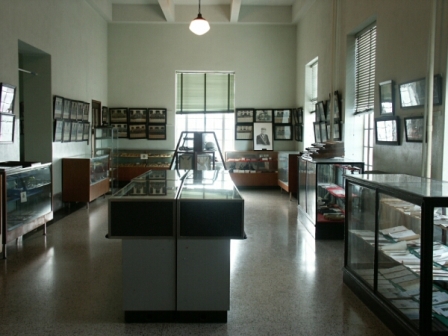
These pipes were discovered in the Auditorium back in the days when smoking as permitted in the building. Since the degrees of the Scottish Rite are done theatrically, the Auditorium would get very dark... and very warm.... and very comfortable... and members... would... drift off... to... sleep........ then drop whatever was in their hands, forget they'd done it, then go home after the Reunion was over; and rather than admitting they'd been asleep, the members would leave their pipes where they fell.

These pipes were discovered in the Auditorium back in the days when smoking as permitted in the building. Since the degrees of the Scottish Rite are done theatrically, the Auditorium would get very dark... and very warm.... and very comfortable... and members... would... drift off... to... sleep........ then drop whatever was in their hands, forget they'd done it, then go home after the Reunion was over; and rather than admitting they'd been asleep, the members would leave their pipes where they fell.
Well, as it so happens, the cleaning crews gathered so many of them
together that they decided to put them on display to make an example
of the sleepers.
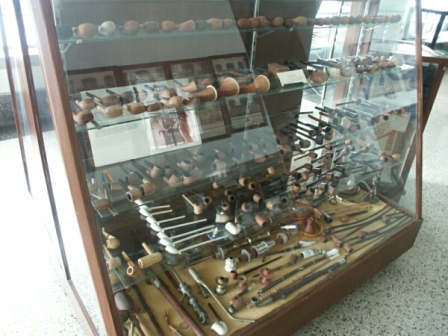
of the sleepers.
Egyptian Auditorium Stage
The stage of the Egyptian Auditorium is where all the degrees of the
Scottish Rite for the Valley of McAlester are performed. It is one
of the largest west of the Mississippi River - 80' x 120' with a 90'
x 90' proscenium arch.
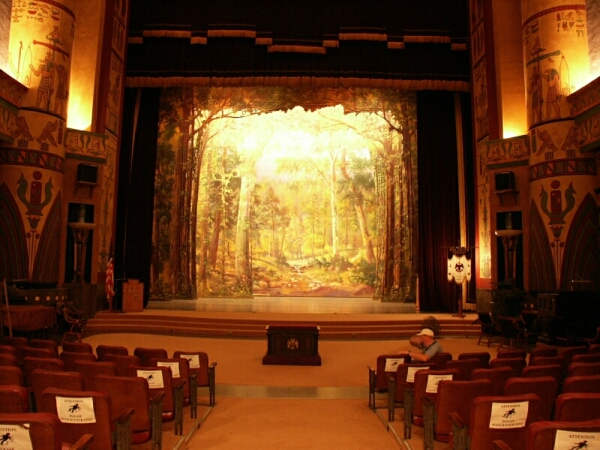
As you look to the ceiling of the Auditorium, you'll notice a huge
grilled rosette. This is the sound escape hatch for the 51 rank, 3,100
pipe Kimball pipe organ housed above the ceiling.
When the organ was installed in early 1929, the pipes were set in place
and the top of the building was built around it; then the stock market
crashed in October so the leadership of the time couldn't make the
payments.
The manufacturers came to McAlester to tell the leadership, "Since we
haven't received payment from you, we're here to repossess your organ."
"You go right up there and you take it," was the considered reply from
the leadership.
And so they made the attempt. The representatives from Kimball climbed
the tight, four-story spiral staircase to find the pipes were packed
securely behind tons of brick with no way to transport the pipes to the
ground. They came back down and said, "We'll work with you."
Thus, the pipe organ has remained in the possession of the McAlester
Scottish Rite since its installation.
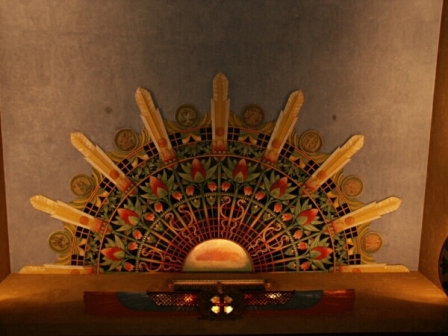
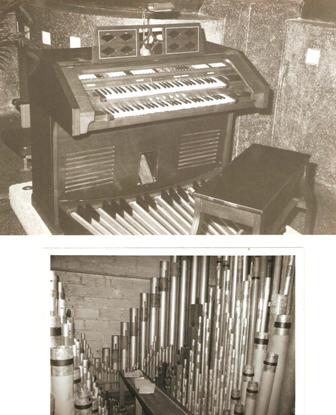

Egyptian Auditorium House
The House seats 710 and is decorated in an elaborate Egyptian style
in the vein of the Temple of Karnak. The decor was inspired by the
public interest generated by Howard Carter's find of Tutankhamun's
tomb in 1922.
This is the Egyptian-styled Double-Headed Eagle that looks out
over the proceedings within the Auditorium.
The Double-Headed Eagle is the oldest element known in heraldry
and dates to the Hittite Empire of the 14th century BC. As a
symbol it is used to teach that in order to know where we're
going, we must always look to the past.Above
the eagle is the choir loft. In the days before an
electronic sound system in the Auditorium, non-members and
women would go up there and sing. It may seem an odd
placement, but the acoustics of the Auditorium are such that
sound travels out and is thrown downward rather than
travelling up in a typical theatre setup.
The hieroglyphs on the pillars surrounding the Auditorium house
tell the story of the Trial of the Soul of Cheres.
Cheres has been brought in front of the gods so they can judge
if he is worthy to enter the afterlife. His good deeds are
placed on one side of the scale, and coins are dropped on the
other to symbolize all of the transgressions and sins he caused
in life. At the end of the trial, the scales are so evenly
balanced a feather's weight would seal Cheres' fate.
This is used to teach the Scottish Rite Mason that it matters
little of how good you've been or what acts you've committed. In
the end, it's up to God to decide your worth.
Pillar Detail...
Scenic Drops
There are 114 scenic drops housed above the stage (111 scenery and 3
cycloramas) designed to be used in a layered fashion to give
approximately 60 distinct scenes. All the drops have a dimension of
60' x 80,' and are built in typical Broadway-style flat
construction.These were painted and installed from 1931 to 1935 by Thomas Moses,
33°, a professional scenic painter from Chicago. He hand mixed all
of the paints used in the project giving distinct varieties of hues
and opacities making them not only priceless but nigh on impossible
to copy.
When the project was completed in 1935, Brother Moses returned to
Chicago where he passed away a month later.
"State of the Art" Lighting Control Circa 1987 - R.I.P.
In October of 2007, the Colortran 2000 lighting control board, in
modern technical theatre parlance, "ate itself." Another in an
ongoing series of power surges coursed through the building frying
the motherboard then every other circuit in the 20 year-old board.
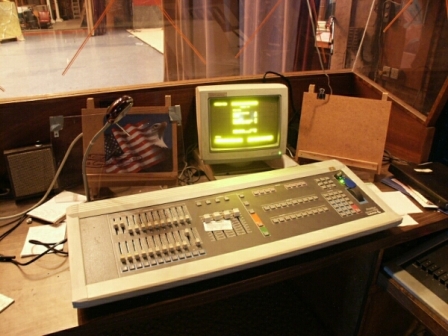
"State of the Art" Lighting Control Circa 1930
The above being said, however, this is how the lights were
controlled until 1987. It took three people to run, and they had to
be absolutely synchronous because nowhere on it is a button that
says "lightning." If necessary, this panel could be used once again
because all of the rheostats and wiring and switching elements still
exist, but it would be an extreme hazard as the wax paper insulation
around the wiring has long since deteriorated.
1930 Lighting Control Breaker Board
The Architects of the New Lighting SystemIn January of 2008, work began on installing a brand-new ETC Ion lighting control system with a secondary wall-mount control unit for backup and tours. James Capers, Director of Work, and Fred Price, head of the Scottish Rite Fire Brigade and electrician, have spearheaded this worthwhile project to upgrade the Auditorium's lighting system into the 21st century. Assisting them in the project are Clem Peppers, Building Superintendant; Jerry Nanny, Lighting Department Supervisor; and Bill Erkin, Almoner.


Costume Storage
This cedar-lined room is where all of the costumes for the Scottish
Rite degrees are stored. Many of the costumes are 30 years old or
older, the oldest of which are from 1910 (and are still used today).In the 1960's one of the members worked for Paramount Studios as
they were clearing out the old costumes from their wardrobe
department. He was able to take approximately 40 various costumes
with him, and as he was traveling back home to Texas, he stopped and
gave us three of those costumes as he knew what the Scottish Rite
degrees needed.
The three costumes he gave to the
McAlester Scottish Rite were from Cecil B. DeMille's 1956 Biblical
epic
The Ten Commandments. You can see one in this picture if
you look closely at the first costume on the second row left. That
is the very one wore by Charleton Heston's Moses as he stood on the
rock parting the Red Sea.In keeping with the theme surrounding it, the actor currently
playing Moses in the degrees also wears that particular costume.